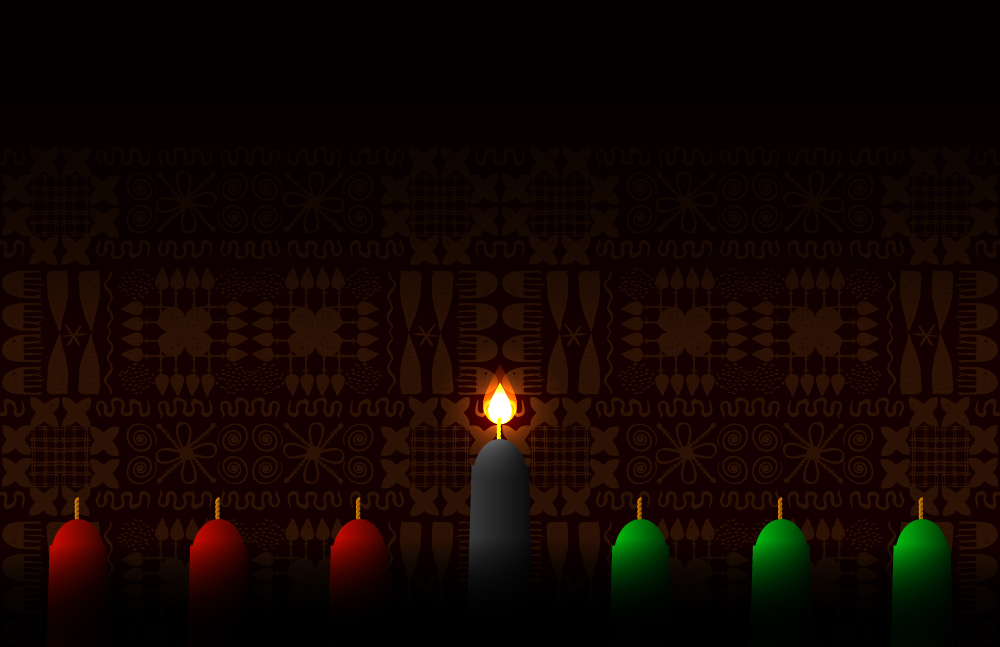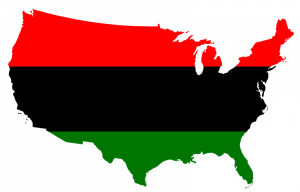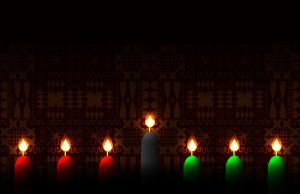Kwanzaa is a cultural celebration that begins on 26 December and ends on 01 January. Kwanzaa is not a religious observance, but there is no denying that the celebration has a very spiritual aura that surrounds it. Kwanzaa is a celebration of “the first fruits” of the harvest and was created 55 years ago in 1966 by Maulana Karenga as an African-American and Pan-African holiday.
The actual Kiswahili word is kwanza, which means “first.” Karenga added the second “A” to the end of kwanza to coincide with the seven principles of the celebration.
The Nguzo Saba, the Seven Principles of Kwanzaa, are designed to reinforce African cultural principles.
Each day a candle is lit in the kinara [kee-nah-ruh], the holder for the seven candles; three red candles on the left, one black candle in the middle, three green candles on the right.
The black candle in the middle of the kinara is lit on this first day of the celebration.

The colors of Kwanzaa represent:
- red for the struggle
- black for the people
- green for hope
The following list outlines which candle is lit on each day, what principle is celebrated on each day and what each principle represents:
26 December
- the lighting of the black candle in the middle of the kinara
- Umoja [oo-moe-juh] means unity
- “to strive for and maintain unity in the family, community, nation and race”
27 December
- the lighting of the red candle next to the black candle in the kinara
- Kujichagulia [koo-jee-chah-goo-lee-yuh] means self-determination
- “to define ourselves, name ourselves, create for ourselves and speak for ourselves”
28 December
- the lighting of the green candle next to the black candle in the kinara
- Ujima [oo-jee-muh] means collective work and responsibility
- “to build and maintain our community together and make our brother's and sister's problems our problems and to solve them together”
29 December
- the lighting of the middle, red candle in the kinara
- Ujamaa [oo-jah-muh] means cooperative economics
- “to build and maintain our own stores, shops and other businesses and to profit from them together”
30 December
- the lighting of the middle, green candle in the kinara
- Nia [nee-yuh] means purpose
- “to make our collective vocation the building and developing of our community in order to restore our people to their traditional greatness”
31 December
- the lighting of the outside, red candle in the kinara
- Kuumba [koo-oom-bah] means creativity
- “to do always as much as we can, in the way we can, in order to leave our community more beautiful and beneficial than we inherited it”
01 January
- the lighting of the outside, green candle in the kinara
- Imani [ee-mah-nee] means faith
- “to believe with all our heart in our people, our parents, our teachers, our leaders and the righteousness and victory of our struggle”
Aside from the kinara, there are several other items that are implemented to celebrate Kwanzaa:
- corn (muhindi [moo-heen-dee]) - an ear of corn for each child in the family
- fruits and vegetables (mazao [muh-zah-o]) - the harvest
- straw mat (mkeka [muh-kay-kuh]) - all the symbols of the celebration sit on the straw mat
- seven candles (mishumaa saba [mi-shoo-mah-ah sah-bah]) - three red, one black, three green candles
- seven-slotted candle holder (kinara [kee-nah-ruh]) - the centerpiece of the Kwanzaa symbols
- unity cup (kikombe cha umoja [kee-koME-bay chah oo-moe-juh]) - used to pour libations to the ancestors
- flag (bendera [ben-dare-rah]) - the red, black and green flag, based on the colors chosen by Marcus Garvey to represent Africans throughout the diaspora
- gifts (zawadi [zuh-wah-dee]) - Kwanzaa gifts are to be hand-made and educational
- feast (karamu [kuh-rah-moo]) - family members and friends get together to share the Kwanzaa celebration
Although Kwanzaa is recognized on a specific seven days of the year, the principles of Kwanzaa are meant to be observed/implemented all year long, using the Nguzo Saba as a foundation for ways to implement each principle. For example, a family game night could be one way of practicing unity (umoja) or buying gifts from an African-American/African/Caribbean cultural festival could be a way of practicing cooperative economics (ujamaa).
On each of the seven days of Kwanzaa the greeting is “Habari gani [huh-bah-ree-gah-nee],” which means “What's happening today?” to which the response is the principle for that day.
So let's begin the 2021 Kwanzaa celebration…
Call: Habari gani!
Response: Umoja!
According to the Nguzo Saba, as written by Maulana Karenga, unity means:
to strive for and maintain unity in the family, community, nation and race
* for more information on Kwanzaa please visit The Official Kwanzaa Website.


